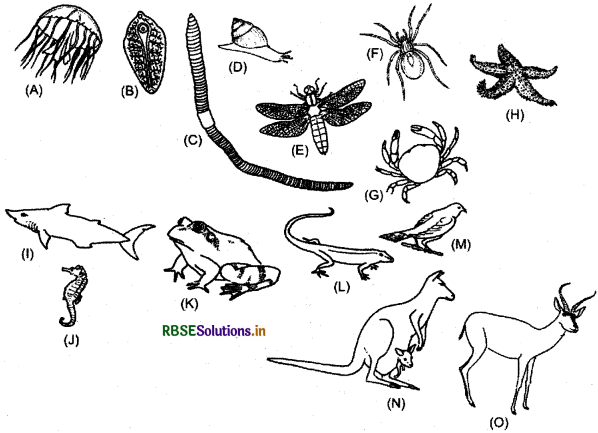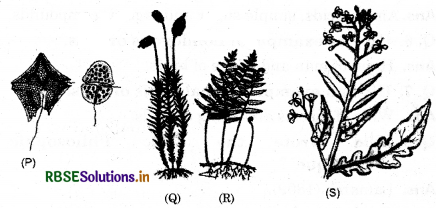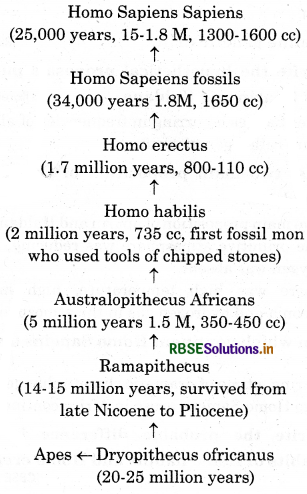RBSE Solutions for Class 12 Biology Chapter 7 Evolution
Rajasthan Board RBSE Solutions for Class 12 Biology Chapter 7 Evolution Textbook Exercise Questions and Answers.
Rajasthan Board RBSE Solutions for Class 12 Biology in Hindi Medium & English Medium are part of RBSE Solutions for Class 12. Students can also read RBSE Class 12 Biology Important Questions for exam preparation. Students can also go through RBSE Class 12 Biology Notes to understand and remember the concepts easily. Browsing through manav janan class 12 in hindi that includes all questions presented in the textbook.
RBSE Class 12 Biology Solutions Chapter 7 Evolution
RBSE Class 12 Biology Evolution Textbook Questions and Answers
Question 1.
Explain the antibiotic resistance observed in bacteria in the light of Darwinian selection theory.
Answer:
When a bacterial population is subjected to a dose of a particular antibiotic, the bacteria which are sensitive die & therefore the population is wiped off while a few mutant bacteria undergo are resistant to the antibiotic and therefore they survive. These resistant bacteria multiply rapidly as the competing bacteria have already died due to antibiotic effect. Soon the mutant population increases & mutated gene or antibiotic resistance becomes quite widespread and whole of the resultant bacterial population becomes resistant to the given antibiotic.

Question 2.
Find out from newspaper and popular articles any new fossil discoveries about evolution.
Answer:
Fossils of dinosaurs have been discovered from the rocks of mesozoic era. They reveal that the Jurossic period of Mesozoic was the age reptiles, primitive birds and mammals. The evolution of great reptiles and mammals have taken place in this period. Recently a fossil of shark-toothed reptile has been discovered from Sahara desert. Also a flying bird with teeth in jaw has been discovered from upper Jurassic which reveals controversy about the path of evolution.
Question 3.
Attempt giving a clear definition of the term species.
Answer:
A biological species is a group of organisms that can reproduce with one another is nature and produce fertile offspring. The term species can also be defined as the most basic category in the system of taxonomy.
Question 4.
Try to trace the various components of human evolution (Hint : brain size and function. skeletal structure, dietary preference, etc.)
Answer:
|
Evolution of Brain (in human - brain volume) |
Skeletal Structures |
|
1. Australopithecus (450 - 600 cc) Hojno erectus (900 - 1200 cc) Nearderthal man (1400 cc) Cromagonon (2200 cc) Homo sapiers (2500 cc). |
1. In apes - The backbone forms a simple arch, arms are longer than legs. In man - The backbone is S - shaped and legs are longer than arms. |
|
2. Increase in grey matter. |
|
|
3. Increase in no of gyri and sulci in brain hypothalamus. |
|
Dietary Preference:
Dryopithecus and Ranapithecus: Herbivores Australopithecus Africans, Homo carniver habilis. Herivivorous Homo erectus, Homo Sapiens - Omnivores.
Question 5.
Find out through internet and popular Science articles whether animals other than man has self - consciousness.
Answer:
Recent studies on self consciousness says gibbons are the nearest to human in this respect. Apes and oranguatars come next. Among domestic animals, dog and other members of Canidae family show subtle self consciousness.
Question 6.
List 10 modern - day animals and using the internet resources link it to a corresponding ancient fossil. Name both.
Answer:
- Cockroach, limulus (King crab), Neopilina, latimeria (fish) are fossil that has remain unchanged over years.
- Tribalites - fossil arthropods.
- Lung fishes - connecting link between fishes and amphibians.
- Peripatus - connecting link between arrelids and arthropods.
- Woody Mammoth - ice fossils.
- Gastropods - Would and cast fossil.
- Giant elk - amber fossil of asphalt.
- Dinosaur footprint - inprints.

Question 7.
Practise drawing various animals and plants.


Answer:
(A) Jelly fish
(B) Liver fluke
(C) Earth worm
(D) Snail
(E) Dragon fly
(F) Spider
(G) Crab
(H) Starfish
(I) Fish
(J) Hippocampus
(K) Frog
(L) Camilion
(M) Hawk
(N) Kangaroo
(O) Deer
(P) Dinoflagellates
(Q) Moss
(R) Fern
(S) Mustard.
Question 8.
Car we call human evolution as adaptive radiation?
Answer:
Yes, human evolution is example of adaptive radiation as different species of human evolved across different areas of world as they diverged to different areas in the following fashion.
- Hominid introduction occurred in Africa and Asia:
- Homo habilis lived in Africa - 2 million years ago.
- Homo erectus - migrated to Asia and Europe and diverged into 2 species - Java Man and pecking Man.
- Similarly Homo erectus - was followed by Homo sopierns.
- Prinitive Neanderthal man in Europe gave way to African Cro - Magnon.

Question 9.
Describe one example of adaptive radiation.
Answer:
Darwin’s finches of the Galapagos islands had common ancestors but now have different types of modified beaks according to their food habit.
Question 10.
Using various resources such as your school library or the internet and discussions with your teacher, trace the evolutionary stages of any one animals say horse.
Answer:
Evolutionary stages of horse:
Eohippus - Hesohippus - Merychippus - phichippus - Equus.
- Increase in body size.
- Elongation of neck.
- Lengthening of limbs.
- Enlargement of third digit.
- Increase in structural complexity of teeth for feeding on grass.

- RBSE Class 12 Biology Notes Chapter 16 पर्यावरण के मुद्दे
- RBSE Class 12 Biology Notes Chapter 15 जैव-विविधता एवं संरक्षण
- RBSE Class 12 Biology Notes Chapter 14 पारितंत्र
- RBSE Class 12 Biology Notes Chapter 13 जीव और समष्टियाँ
- RBSE Class 12 Biology Notes Chapter 12 जैव प्रौद्योगिकी एवं उसके उपयोग
- RBSE Class 12 Biology Notes Chapter 11 जैव प्रौद्योगिकी-सिद्धांत व प्रक्रम
- RBSE Class 12 Biology Notes Chapter 10 मानव कल्याण में सूक्ष्मजीव
- RBSE Class 12 Biology Notes Chapter 9 खाद्य उत्पादन में वृद्धि की कार्यनीति
- RBSE Class 12 Biology Notes Chapter 8 मानव स्वास्थ्य तथा रोग
- RBSE Class 12 Biology Notes Chapter 7 विकास
- RBSE Class 12 Biology Notes Chapter 6 वंशागति के आणविक आधार